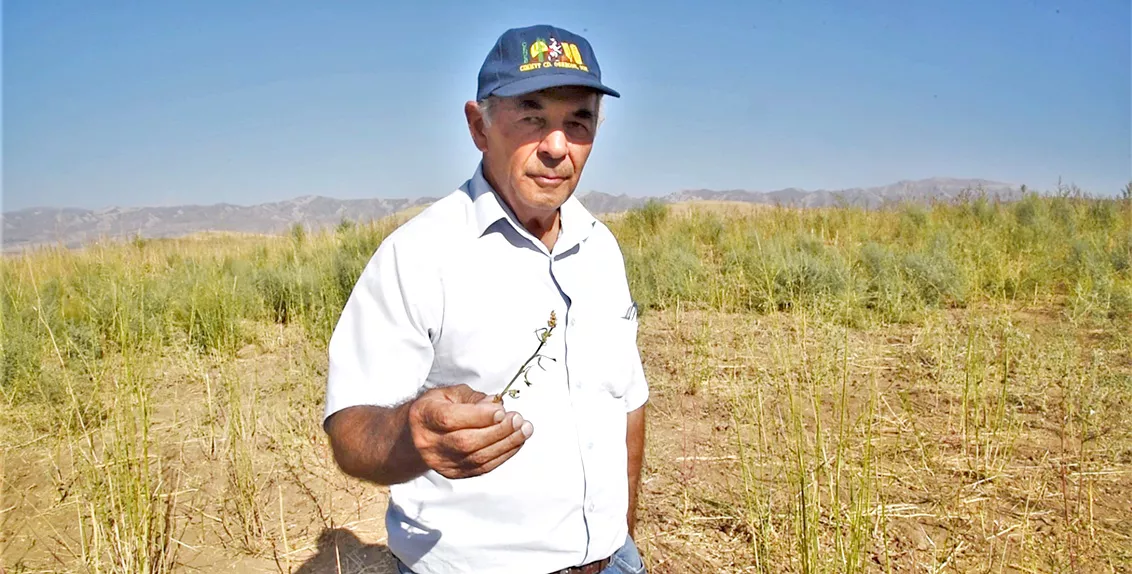One Tajik scientist’s decades-long pursuit of quinoa
30 October 2018
Standing atop a hill, Dr. Mavlon Pulodov watches a vast field below. Down lies a breathtaking view of Tajik mountains, slopes covered with a huge orange carpet made of wheat remains, and a piece of land with tall quinoa stems, standing straight as guards.
2018 marks the end of his 33-year-long quest for quinoa, a wonder crop from the Andes. But the crop’s journey in Tajikistan only begins. After years of trials, a farmer from southern Tajikistan has collected 600 kilograms of quinoa seed for the first time.
Dr. Mavlon Pulodov, a retired director of the National Center for Genetic Resources of the Tajik Academy of Agricultural Sciences, cannot hide his contentment: the seed yield is enough to cover 100 hectares of land next year.
Although quinoa was officially introduced in Tajikistan in 2013, Dr. Mavlon Pulodov first encountered the crop back in 1985, when he was an aspiring researcher at the department of plant breeding and seed production of cereals and forage crops. Mr. Petru Lucinschi, then the second secretary of the Central Committee of the Communist Party of Tajikistan, handed him a bag of seeds he had brought from Bolivia. “They make bread out of this,” he said. “We should stop concentrating on wheat and try other options.”
On the fifth day of planting, the seeds emerged and stopped evolving after two weeks. Watering the seedlings everyday did not help. After a month, sprouting resumed, looking more like a goosefoot, known as shurak, a local variety of weed with a slight difference in branching and forming flower heads. Apparently, a man of office did not know the difference between domesticated crop and wild weed. When the stems reached the human height, inpatient and disappointed, he offered to cut it for green mass. “This is a good forage crop,” he insisted. Without a single seed for future trials, the crop was mown.
In 1991, the Soviet Union collapsed, and Tajikistan gained independence. In 1996, Mr. Petru Lucinschi was elected Moldova's second president. However, Dr. Mavlon Pulodov’s regret of his decision not to preserve quinoa seeds remained. He continued searching for traces of information on the exotic crop from the Andes.
Devastating impacts of the civil war in 1992-1997 on food security were exacerbated by climate change in Tajikistan in the 2000s. Following three years of reduced harvests, Tajikistan was hit by a severe drought, affecting thousands of rural people, especially in the south. Heat- and drought-tolerant quinoa could have helped to address the drought during those years.
With access to the internet, Dr. Mavlon Pulodov started learning more about the crop. His research came in handy when the Food and Agriculture Organization of the United Nations (FAO) in Tajikistan launched a quinoa project and handed over seven seed varieties to national partners for field trials.
In 2015 the International Center for Biosaline Agriculture (ICBA) joined the quinoa drive with financial support of the Islamic Development Bank (IsDB). ICBA provided scientists and farmers in Tajikistan with seeds of five improved salt- and drought-resistant quinoa varieties from ICBA’s gene bank.
It seemed like history was repeating itself: first came farmers’ curiosity, then cultivation of seeds, disappointment upon germination and calls to water the seedlings. But Dr. Mavlon Pulodov had to patiently convince farmers that the crop does not need irrigation at this time.
In Tajikistan’s rain-fed conditions, quinoa seeds sprout within five days. Upon reaching 15 cm in height, the process slows for a month. Then it resumes with daily growth of 3-5 cm until it reaches 1.5-2 meters. Unlike maize and other crops, its flowering stage lasts for 35-40 days. For fodder production, up to 300 kilograms per hectare of green mass can be harvested during the flowering period. The yield from early-maturing varieties can reach 1.2 tonnes per hectare.
As a quinoa expert, Dr. Mavlon Pulodov has been advising farmers and international organizations working in Tajikistan. In April 2018, the representatives of Caritas Switzerland, an international aid agency working on food security, water and climate change, contacted him to acquire quinoa seeds and asked him to help cultivate it in the south of Tajikistan.
Since seeds were very small, Dr. Mavlon Pulodov mixed them with sand and sowed by hand on one hectare of land in late April 2018. On a larger field, quinoa once again proved its low-maintenance and cost-effective status: the farmer had spent around 140 USD for ploughing, mineral fertilizers, harvesting and transportation of the yield from the field. Caritas purchased the harvest for distribution in southern Khatlon Region during the next season.
As an advocate of quinoa in the country, Dr. Mavlon Pulodov keeps asking local farmers the same question during the meetings: “How many of you consume potatoes and tomatoes every day?”
Less than a hundred years ago, these vegetables, originated in Latin America, were not part of the Tajik diet. “Today they have become a staple food on our table,” he continues. With rising temperatures and decreasing wheat yields, climate-smart quinoa holds all chances to alter food preferences in Tajikistan. This time, Dr. Mavlon Pulodov will not give up.











